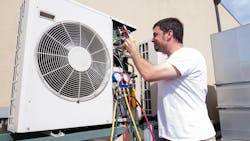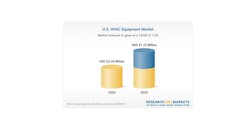US HVAC Equipment Market is projected to grow to $41.22 billion by 2033
DUBLIN — ResearchAndMarkets.com announced the availability of a new report: The "United States HVAC Equipment Market Size and Share Analysis - Growth Trends and Forecast Report 2025-2033."
According to the report, the U.S. HVAC Equipment Market is expected to reach $41.22 billion by 2033, up from $22.44 billion in 2024, with a CAGR of 6.99% from 2025 to 2033
Due to a number of variables, the HVAC equipment industry in the US is expanding rapidly. Because of the United States' large geographic area, temperatures can vary greatly by state, city, and coast, ranging from extremely cold to extremely hot. Because of this climate unpredictability, HVAC installations are crucial in both residential and business settings. Therefore, the urgent necessity to control indoor temperatures independent of the outside weather supports the expansion of the HVAC sector in the country.
With a rising need for smart and energy-efficient technology, the HVAC (heating, ventilation, and air conditioning) equipment business in the US is essential to both the residential and commercial sectors. Climate control systems are becoming more and more necessary as a result of variables including urbanization, population expansion, and climate change.
The market is changing because to technological developments including automation, environmentally friendly refrigerants, and the incorporation of Internet of Things (IoT) capabilities. Manufacturers are being driven to innovate by the trend toward sustainable and energy-efficient solutions, which is being spurred by tighter laws and customer demand for greener options. Large corporations including as Carrier, Trane, and Lennox are making investments in high-performance systems that have lower environmental impact and energy use.
The increased focus on health and air quality, particularly in the wake of the pandemic, is also helping the HVAC sector because air filtration systems are now a standard feature of building designs. Additionally, the need for linked HVAC systems that can be regulated remotely for comfort and efficiency is growing as smart home technologies become more prevalent. The HVAC equipment market is anticipated to increase consistently as a result of the growing number of residential and commercial building projects, as well as the retrofit and replacement sectors. Long-term sustainability and market diversification are also being fueled by developments in geothermal heating and cooling technology.
To increase energy efficiency, the US government is expanding building rehabilitation programs. Energy expenses for companies and homes are reduced by these energy-efficient improvements, which also reduce greenhouse gas emissions. They improve indoor air quality, highlighting their importance for public health and creating an atmosphere that is favorable for market expansion. In June 2024, for instance, the Administrator of the US General Services Administration (GSA) announced a proposal to invest USD 80 million from the Inflation Reduction Act (IRA) in intelligent building technology. Across over 560 federal buildings, these systems seek to reduce emissions, increase efficiency, reduce expenses, and improve comfort levels.
The nation's adoption of smart home technology is being propelled by rising consumer awareness of sustainability and energy efficiency, which is also fostering an environment that is conducive to the development of cutting-edge HVAC systems. For example, the US smart home hardware sales income was projected to reach USD 23.5 billion in 2023, up from USD 19.70 billion in 2018, according to the Consumer Technology Association (CTA). Therefore, it is anticipated that the convergence of these trends would sustain the expansion of the market under study during the forecast period.
For more information, visit www.researchandmarkets.com.

